Wednesday, May 29, 2024
Friday, May 24, 2024
Power of Amazon Advantage: A Comprehensive Guide for Publishers, Authors, and Content Creators
Power of Amazon Advantage: A Comprehensive Guide for Publishers, Authors, and Content Creators

Maximizing Your Reach and Sales Potential with Amazon Advantage
Amazon Advantage is a program designed to help publishers, authors, musicians, filmmakers, studios, and other media content creators expand their reach and boost sales by listing their products directly on Amazon.
By enrolling in Amazon Advantage, you gain access to a suite of tools and features that enable you to manage your operations, marketing, and reporting while tapping into Amazon’s vast customer base and leveraging the power of Amazon Prime.
Is Amazon Advantage more like Vendor Central or Seller Central?
Amazon Advantage is closer to Vendor Central than Seller Central.
Amazon Advantage vs. Vendor Central vs. Seller Central
Amazon Advantage:
- Direct Sales to Amazon: In Amazon Advantage, you sell your products directly to Amazon. Amazon then handles the sales, deliveries, customer service, returns, and refunds, similar to Vendor Central's operations.
- Control Over Listings: While you have some control over product listings and can use promotional tools, Amazon sets the retail price and manages much of the sales process.
- Suitable for: Publishers, authors, musicians, filmmakers, studios, and other media content creators who want to sell physical media products (like books, CDs, DVDs) directly to Amazon.
Vendor Central:
- Wholesale Relationship: In Vendor Central, you operate as a supplier or wholesaler to Amazon. You sell products in bulk to Amazon, and Amazon sells them to customers.
- Amazon’s Responsibility: Amazon handles the pricing, customer service, and logistics.
- Invitation-Only: Vendor Central is typically by invitation only and often involves larger brands and manufacturers.
Seller Central:
- Marketplace Sales: In Seller Central, you sell your products directly to customers on the Amazon marketplace. You are responsible for pricing, customer service, and sometimes fulfillment unless you use Fulfillment by Amazon (FBA).
- Greater Control: Sellers have more control over their listings, pricing, and customer interactions.
- Suitable for: Individual sellers, small businesses, and larger enterprises who want more control over their sales process.
Key Differences
Sales Model:
- Amazon Advantage and Vendor Central: Operate on a wholesale model where you sell to Amazon.
- Seller Central: Operates on a marketplace model where you sell directly to customers.
Control:
- Amazon Advantage and Vendor Central: Amazon controls pricing and customer interactions more.
- Seller Central: Sellers have more control over pricing and customer interactions.
Fulfillment:
- Amazon Advantage and Vendor Central: Amazon manages fulfillment.
- Seller Central: Sellers can manage fulfillment themselves or use FBA.
We mentioned that Amazon Advantage aligns more closely with Vendor Central in selling directly to Amazon, which then sells to the end customers, handling much of the sales and fulfillment process. This contrasts with Seller Central, where sellers have a direct relationship with customers and more control over their listings and pricing.
Key Benefits of Amazon Advantage
- Direct Relationship with Amazon: Amazon Advantage allows you to sell your products directly to Amazon, which then handles the sales, deliveries, customer service, returns, and refunds. This streamlined process saves you time and resources while leveraging Amazon’s trusted brand. Your relationship with Amazon means they also handle the shipping cost, reducing your operational burden.
- Enhanced Visibility: Products listed through Amazon Advantage benefit from Amazon’s “Ships from Amazon.com” and “Sold by Amazon.com” messaging on the product detail page, instilling confidence in potential buyers. This visibility is crucial for increasing sales and reaching new customers, including those who frequent Amazon’s foods market.
- Marketing and Promotional Tools: Amazon Advantage members can utilize features like Lightning Deals, Amazon Advertising, A+ enhanced detail pages, and Vine to drive traffic and increase sales. These tools, available through Vendor Central, improve your product listings and boost visibility. Exclusive deals and prime access are great ways to attract more potential buyers.
- Pre-order Functionality: As long as the release date is confirmed, you can list upcoming titles for pre-order before shipping your inventory to Amazon. This feature helps generate buzz and secure sales before launching your product.
- Amazon Prime Eligibility: Stocking your products in Amazon’s fulfillment centers makes them eligible for Prime shipping, a significant draw for many customers and Amazon Prime members. This benefit enhances customer satisfaction and loyalty.
- Comprehensive Reporting and Insights: Amazon Advantage provides access to valuable data and insights that help you make informed decisions and maximize your sales potential. This includes detailed reports on inventory levels, customer behavior, and sales performance. You can also track your savings and efficiency improvements.
Enrolling in Amazon Advantage
To join the U.S. Amazon Advantage program, you must meet specific requirements, such as having North American distribution rights for your titles, a U.S. address for returns, a valid email address and internet access, and scannable barcodes on every item.
The application process is straightforward, and once approved, you’ll gain access to the Amazon Advantage account on Seller Central, where you can manage your listings, confirm orders, and add new titles.
Costs and Terms
As of August 2023, the U.S. Amazon Advantage program has a non-refundable annual fee of $99. Payments are calculated based on the List Price you set for your products minus Amazon’s purchase discount.
The standard purchase discount for books is 55%, meaning you retain 45% of the List Price. Amazon determines the retail price customers pay and automatically pays you at the end of the month following the month in which your product is sold.
Amazon Advantage vs. Other Amazon Selling Options
While Amazon offers various selling options, such as Kindle Direct Publishing and the Amazon Seller program, Amazon Advantage is particularly well-suited for publishers, authors, and content creators who have physical inventory to ship and want to benefit from Amazon’s fulfillment services and promotional features.
Amazon FBA (Fulfillment by Amazon) is another popular option for sellers, but it may offer a different level of customization and control than Amazon Advantage.
Additional Features
- Amazon Brand Registry: Protect your brand and access powerful tools to enhance product listings.
- Amazon Music and Amazon Prime Day: Leverage special events and platforms to promote your content.
- Gift Cards and Savings: Utilize Amazon’s promotional offers to attract more customers.
- Prime Access and Exclusive Deals: Offer exclusive products and benefits to Prime members, enhancing customer loyalty.
- Rights Reserved and User Agreement: Ensure you comply with Amazon’s terms and protect your intellectual property.
- Storage Fees: To manage your budget effectively, understand the costs of storing your products in Amazon’s fulfillment centers.\
- Amazon Employee Support: Benefit from the support and expertise of Amazon employees who help ensure your success on the platform.
- Shipping Cost Management: Optimize your shipping costs by leveraging Amazon’s logistics network.
- Amazon Team and Newsletter: Stay informed with updates from the Amazon team and newsletters tailored to your needs.
- Engaging Amazon Customers: Build relationships with Amazon customers through exceptional service and high-quality products.
- Reaching Potential Customers: Use Amazon’s platform to reach new potential customers and expand your market.
Considerations
While Amazon Advantage offers numerous benefits, there are some potential drawbacks to consider:
- Annual Fee: Amazon Advantage charges a non-refundable annual fee of $99 for U.S. members, which may be a significant expense for smaller publishers or content creators.
- Limited Control Over Pricing: Amazon determines the retail price customers pay for your products. This means you have less control over pricing strategies and may not be able to run promotions or discounts independently.
- Inventory Management: Although Amazon handles the storage and fulfillment of your products, you are responsible for maintaining adequate inventory levels. Failure to keep up with demand or experience stockouts can negatively impact your sales and customer satisfaction.
- Returns and Refunds: Amazon manages customer returns and refunds on your behalf, which can simplify the process. However, you may have less visibility into the reasons for returns, making it harder to identify and address potential issues with your products.
- Limited Direct Customer Interaction: Since Amazon handles the sales process and customer service, you may have fewer opportunities to build direct relationships with your customers or gather valuable feedback.
- Product Restrictions: Amazon Advantage currently accepts a limited range of physical products, such as books, music, and videos. If you offer digital content or other types of products, you may need to explore alternative selling options.
- Competitive Marketplace: While Amazon’s vast customer base is a significant advantage, it also means you’ll be competing with numerous other publishers and content creators for visibility and sales. Standing out in a crowded marketplace can be challenging.
- Dependence on Amazon: By relying heavily on Amazon Advantage for sales and distribution, you may become dependent on the platform. Any changes to Amazon’s policies, algorithms, or fees could significantly impact your business.
- Payment Terms: Amazon pays vendors at the end of the month following the month in which the product was sold. This means there may be a delay in receiving payment for your sales, which can impact cash flow.
- Limited Customization: While Amazon Advantage allows you to provide product information and some marketing content, the overall selling experience is standardized. You may have less ability to customize your brand’s presentation than selling through your website or other channels.
Before enrolling in Amazon Advantage, consider potential drawbacks. While some drawbacks are similar to other Amazon selling and retail programs, weigh these considerations against the benefits to determine if they align with your business goals and resources.
Summary
Amazon Advantage is a comprehensive and robust program that empowers publishers, authors, and content creators to reach a wider audience, increase sales, and streamline their operations.
By leveraging Amazon’s robust platform, Amazon Prime, and features such as Amazon Brand Registry, Amazon Advantage members can focus on creating exceptional content while leaving the complexities of fulfillment and customer service to Amazon.
Power of Amazon Advantage: A Comprehensive Guide for Publishers, Authors, and Content Creators was originally published in Openbridge on Medium, where people are continuing the conversation by highlighting and responding to this story.
from Openbridge - Medium https://ift.tt/mFosvHS
via Openbridge
Wednesday, May 22, 2024
Tuesday, May 21, 2024
Monday, May 20, 2024
Update: Orders API v0 returns Pix, Boleto, and rewards-based payment method details
Unlock the Secrets to Skyrocket Vendor Central Profits: Eliminate Devastating Financial Scorecard Defects Now!
Unlock the Secrets to Skyrocket Vendor Central Profits: Eliminate Devastating Financial Scorecard Defects Now!

Unlock the Secrets to Skyrocket Vendor Central Profits: Eliminate Devastating Financial Scorecard Defects Now!
Tips, how-to’s, and best practices to optimize the health of your Vendor Central financials
Managing financial transactions within Amazon Vendor Central can be challenging, especially when dealing with late or short payments.
This guide provides a detailed overview of the Financial Scorecard, the common issues it highlights, and the corrective actions vendors can take to ensure smooth and timely payments.
Overview of the Financial Scorecard
The Financial Scorecard offers an in-depth analysis of transactions between vendors and Amazon over a specific period. It helps vendors understand the reasons behind late or short payments related to invoicing, catalog discrepancies, and supply chain issues.
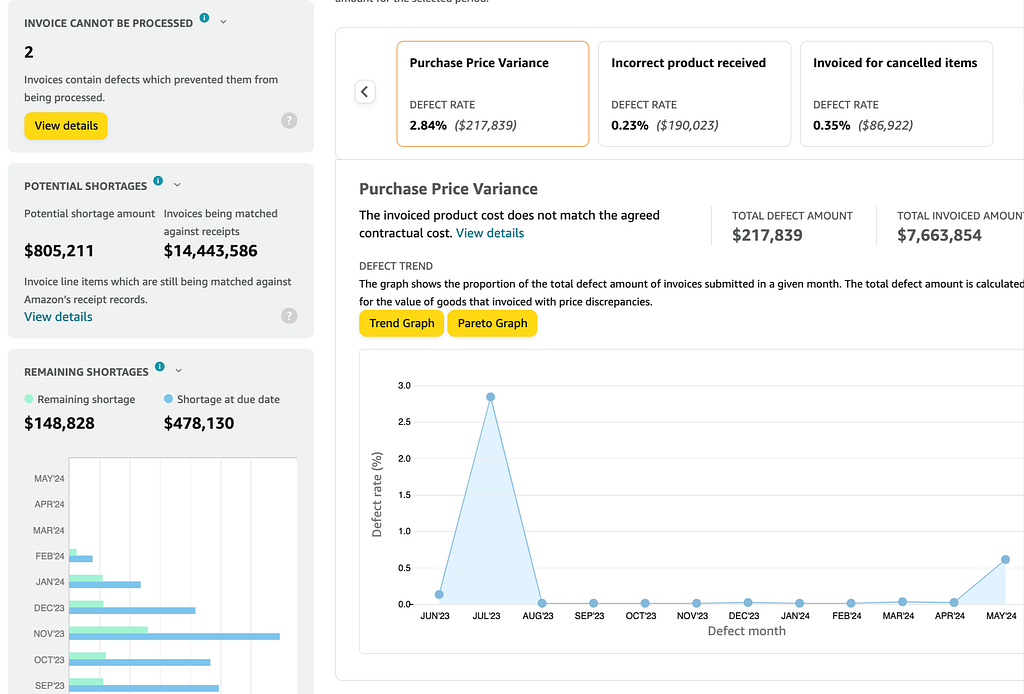
By using the Scorecard, vendors can identify potential gaps in their processes and receive guidance on addressing these issues to improve their business operations.
Common Issues and Corrective Actions
1. Missing Invoices
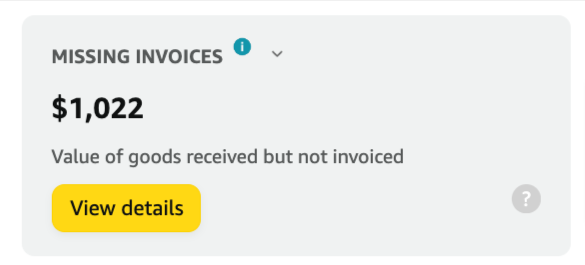
Issue Description:
- Instances where Amazon has received shipments but cannot locate the corresponding invoice.
Corrective Actions:
- Ensure an invoice is submitted when shipping products to facilitate timely payments.
- Avoid submitting invoices via paper or PDF, as these require manual processing and take longer to appear in the system.
- Ensure invoices comply with tax and compliance rules to prevent rejection.
- Do not submit duplicate invoices if one has already been sent.
2. Potential Shortages
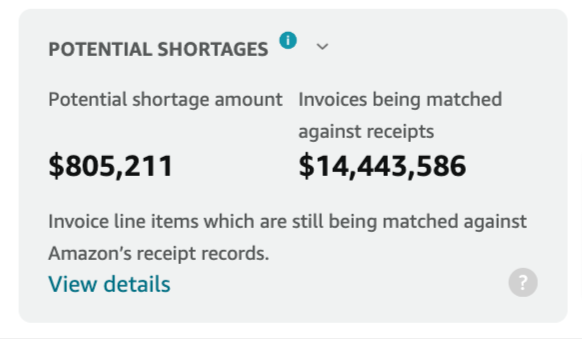
Issue Description:
- Invoice line items are still being matched against Amazon’s receipt records.
Corrective Actions:
- If products have not been shipped, send them promptly or submit a credit memo to release the invoice for payment.
- If the shipment has already been sent, wait for the ongoing matching activities to be completed.
- If items cannot be matched to receipts, they will be moved to remaining shortages.
3. Remaining Shortages
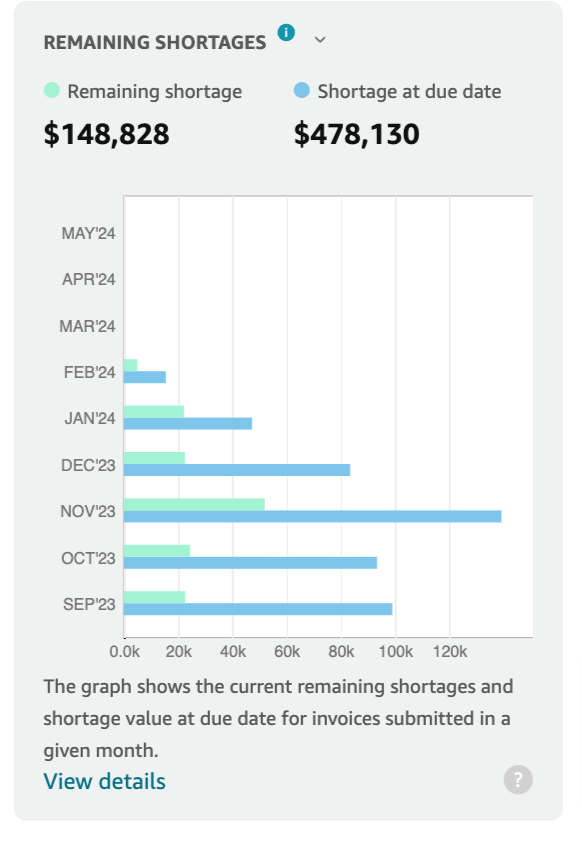
Issue Description:
- Shortages during the payment dispute process after invoice matching and reconciliation.
Corrective Actions:
- Resolve or cancel remaining shortages promptly.
- Send shipments for the shortage quantity within the delivery window to receive payments.
- Submit a credit memo for the shortage quantity if the shipment was not sent.
- Contact Amazon to cancel the Shortage Claim Reversal (SCR) invoice. An SCR invoice lists all remaining unpaid items on an invoice.
Detailed Defects Overview
The Defect Overview provides further insights into specific issues and their resolutions:
Product Not Listed on PO
Issue Description:
- The product on the invoice is not on the purchase order (PO).
Corrective Actions:
- Short-term Solution: Send a credit memo and a new invoice with the correct items.
- Long-term Solution: Ensure invoiced products match the ordered ones and contact Amazon for catalog mapping verification if necessary.
Invoiced Quantity Greater Than Ordered Quantity
Issue Description:
- The invoiced quantity exceeds the quantity on the PO.
Corrective Actions:
- Short-term Solution: Submit a credit memo for the excess quantity.
- Long-term Solution: Ensure the invoice reflects the exact quantity ordered.
Unrecognized Product
Issue Description:
- The product ID on the invoice is not recognized in Amazon’s catalog.
Corrective Actions:
- Short-term Solution: Correct ID issues in the catalog and resubmit the invoice.
- Long-term Solution: Ensure the invoiced and shipped product ID matches the product ordered.
Multiple ASINs for a Single Product
Issue Description:
- The product ID on the invoice refers to multiple ASINs.
Corrective Actions:
- Short-term Solution: Verify and correct the product ID.
- Long-term Solution: Update product details regularly through Items > Edit Products.
Incorrect Unit vs Pack Quantity
Issue Description:
- The product quantity and cost specified on the invoice do not match the PO.
Corrective Actions:
- Short-term Solution: Verify consistency between the PO and the invoice.
- Long-term Solution: Regularly update product details to ensure accuracy.
Late Shipping
Issue Description:
- The shipment arrived at least 14 days after the product was invoiced or the invoice was due for payment.
Corrective Actions:
- Short-term Solution: Ensure timely delivery by coordinating with your carrier.
- Long-term Solution: Issue the invoice on the same day as dispatch and deliver within the PO delivery window.
Invoiced for Cancelled Items
Issue Description:
- Supplying products for purchase order items that were canceled before invoice submission.
Corrective Actions:
- Short-term Solution: Check internal data to verify the items sent and send a credit memo for incorrect items.
- Long-term Solution: Ensure timely delivery and avoid invoicing canceled items.
Incorrect Product Received
Issue Description:
- The received products differ from the invoiced products.
Corrective Actions:
- Short-term Solution: Send a credit memo for the wrong items and a new invoice with the correct items.
- Long-term Solution: Ensure the warehouse team ships products listed on the invoice and PO.
Deleted Appointment
Issue Description:
- The truck delivering the shipment failed to arrive or was rejected at the fulfillment center.
Corrective Actions:
- Short-term Solution: Ensure the carrier arrives at the correct delivery slot.
- Long-term Solution: Create valid appointments for truck deliveries and respect delivery dates.
Purchase Price Variance
Issue Description:
- The invoiced product cost does not match the agreed contractual cost.
Corrective Actions:
- Short-term Solution: Ensure no variance between the PO price and invoice price.
- Long-term Solution: Update product costs as soon as changes occur.
Liquidated Products
Issue Description:
- Delivered products not listed in Amazon’s catalog could not be received.
Corrective Actions:
- Short-term Solution: Send a credit memo for the wrong items.
- Long-term Solution: Ensure the warehouse team ships the products listed on the invoice and PO.
Overages Not Invoiced
Issue Description:
- Items shipped but not ordered or invoiced.
Corrective Actions:
- Short-term Solution: Verify the shipped quantity and submit an invoice for the correct quantity.
- Long-term Solution: Ensure the warehouse team ships the quantity of units confirmed in the PO.
Invoice Cannot Be Processed
Issue Description:
- Invoices containing defects preventing processing.
Corrective Actions:
- Short-term Solution: Check rejected invoices and correct the issues.
- Long-term Solution: Follow the correct guidelines to create and submit invoices.
Submitting a Credit Note (Memo)
When managing your financial transactions with Amazon Vendor Central, you may occasionally need to submit a credit note (memo) if an invoice is placed on hold due to a quantity shortage or price discrepancy. Submitting a credit note helps resolve these issues promptly and ensures your payment process continues smoothly.
Steps to Submit a Credit Note:
Navigate to Payments > Invoices:
- This section allows you to manage and review all your invoices.
Review/Dispute Shortages:
- In the Available Actions section, click on “Review/Dispute shortages”.
- This will allow you to select the specific invoice that requires a credit note.
Select an Action on the Invoice:
- Select the invoice in question and click on “Actions.”
View Invoice Details and Submit Credit Memo:
- In the Available Actions window, click on “View Invoice details”.
- Then, click on “Submit credit memo.”
- Note: You can create a credit note for the total amount or a partial credit note by clicking “Submit ASIN level details.”
Enter Required Details and Submit:
- Fill in the necessary details for the credit note.
- Once all details are entered correctly, click “Submit”.
Alternative Method via Financial Dashboard:
- You can also submit a credit note from the Financial Dashboard:
- Click on “In progress” under “Your payables.”
- Select the invoice that needs a credit memo.
- Choose “Submit credit memo” from the Available Actions drop-down menu.
Following these steps, you can efficiently manage discrepancies and ensure your invoices are processed without delays. Submitting credit notes promptly helps maintain a healthy cash flow and keeps your transactions with Amazon running smoothly.
Understanding Provisions for Receivables
Provisions for receivables are essential to managing your financial transactions with Amazon, mainly when dealing with returns, marketing expenses, and rebates. These provisions act as temporary credit memos, ensuring your account remains balanced even when forecasted costs exceed forecasted payments.
What are Provisions for Receivables?
Provisions for receivables are temporary credit memos that Amazon can place on your account. They are used when the forecasted costs associated with returns, marketing, and rebates due to Amazon exceed the forecasted payments owed to you. The primary purpose of these provisions is to prevent these costs from creating a debit balance on your account.
How Provisions Work:
- Deduction from Payments: Provisions are deducted from the payments due to you.
- Subsequent Adjustment: These provisions are subject to subsequent adjustments based on the actual costs of returns, marketing, and rebates, as well as the actual payments due to you.
Provision Placement:
- When a provision is placed on your account, it will be dated and displayed in the format YYMMDD_PROVISION_FOR_RECEIVABLES.
- For example, a date of 161017 on your remittance means that the provision was placed on October 17, 2023.
Reversing Provisions for Receivables
Temporary Nature:
- The provision for receivables will reverse when invoices for returns, marketing, and rebates are settled or when a decision is made not to return the inventory.
- When a provision is reversed, it will display as YYMMDD_PROVISION_FOR_RECEIVABLESR.
Daily Recalculation:
- Provisions are recalculated, adopted, or reversed daily.
- No invoice copies are associated with these provisions since they are not “real” deductions.
Understanding and managing provisions for receivables helps ensure that your account remains balanced and that you can accurately forecast your financial position with Amazon.
By keeping track of these temporary credit memos and their adjustments, you can maintain a clearer picture of your overall financial health and prevent any unexpected debit balances on your account.
Improving Your Financial Transactions
Vendors can significantly improve their financial transactions with Amazon by regularly reviewing the Financial Scorecard and addressing the issues it highlights.
Here are some general tips for maintaining smooth operations:
- Consistency: Always ensure that invoiced quantities and costs match those on the PO.
- Accuracy: Double-check all details before submitting invoices to avoid rejections and delays.
- Communication: Maintain open communication with Amazon to resolve any discrepancies promptly.
For further training and support, vendors can access additional resources through Vendor Central > Support > Training topics.
By understanding and utilizing the Financial Scorecard, vendors can minimize payment issues, streamline their invoicing processes, and enhance their overall business performance with Amazon.
Unlock Effortless Financial Insights With Our Code-Free Vendor Central Integration
Are you struggling with complex, messy financial data management for Vendor Central? Say goodbye to the hassle.
The Amazon Selling Partner API (SP-API) allows for direct, automated access to Amazon forecasting data, making it easier for businesses to integrate it into their systems. Openbridge allows Amazon Vendors to save time manually downloading reports, increasing data velocity and reducing errors in messy merging and tracking downloaded reports.
Openbridge automation extends beyond financial data to a broad collection of Amazon and non-Amazon data sources;
- Brand Analytics
- Retail Analytics
- Retail Procurement
- Direct Fulfillment
- Real-time Traffic, Sales, and Inventory
- Amazon Advertising
Openbridge offers a seamless, automated solution that unifies your data into a private, trusted data warehouse or data lake like Amazon Redshift, Databricks, Google BigQuery, and more — all without a single line of code. With your data unified, you can use your favorite analytic tools like Power BI, Looker, Tableau, and others for internal teams or external partners.
Automate And Unify Your Vendor Central Data — Free For 30 Days
Start your journey towards data-driven growth and profit with Openbridge. Our code-free, fully automated Selling Partner API integration simplifies your Amazon Vendor Central operations.
Ready to harness the power of your Vendor data?
→ Sign Up Now for Your Free 30-day Trial For Amazon Vendor Central Data Automation.
Unlock the Secrets to Skyrocket Vendor Central Profits: Eliminate Devastating Financial Scorecard Defects Now! was originally published in Openbridge on Medium, where people are continuing the conversation by highlighting and responding to this story.
from Openbridge - Medium https://ift.tt/NMFJPnO
via Openbridge
Friday, May 17, 2024
Amazon Vendor Central Purchase Orders: The Missing Guide
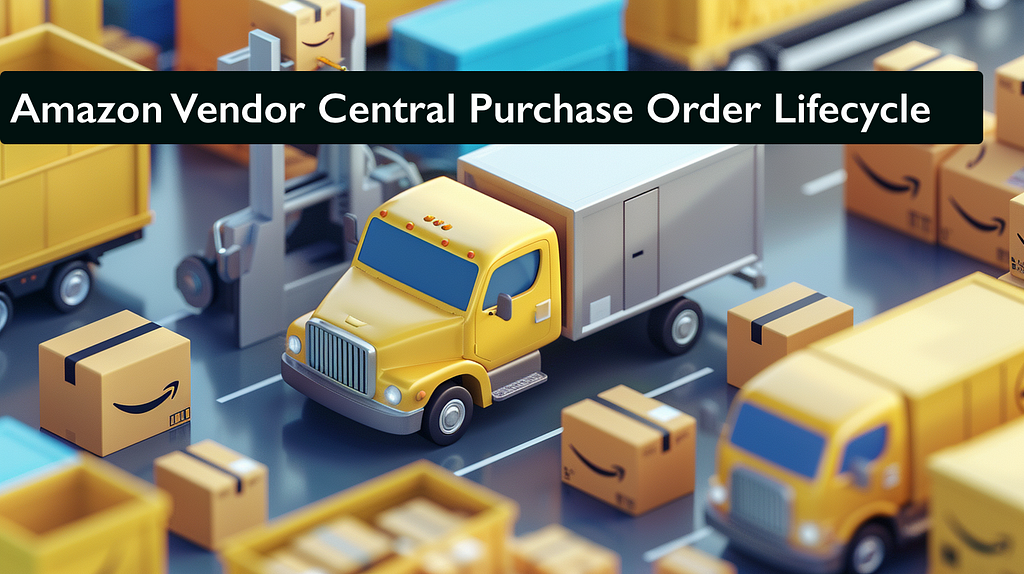
Explore How The Vendor Central Purchase Order Fulfillment Lifecycle Operates
Whether you’re a seasoned operator in Amazon Vendor Central or just trying to understand what a vendor journey on Amazon involves, this guide will be a reference point for daily operations, avoiding potential pitfalls, and maximizing the potential of a partnership in Amazon Vendor Central.
7 Steps In The Amazon Vendor Central Purchase Order Fulfillment Lifecycle
If you are a Vendor, you are well aware there are seven critical stages of the Purchase Order Fulfillment Lifecycle:
- PO Submission
- PO Confirmation
- Transportation Management
- Pick, Prep, and Pack
- Label and Build Pallet
- Submit Shipment
- Shipment Received
Each step highlights Amazon’s order processing and inventory decisions in Amazon Vendor Central.
1. PO Submission
The lifecycle begins with the submission of an Amazon purchase order.
- Automatic Orders: Generated and submitted automatically based on a schedule for each vendor code.
- Manual Orders: Created manually by an In-Stock Manager for specific, non-regular needs.
This initial step involves selecting and finalizing the products ordered from the supplier in Amazon Vendor Central.
2. PO Confirmation
Review and confirm the products. Vendors must confirm PO actions within 48 hours of receipt.
- Product Availability: Confirm if the products can be shipped within the requested window.
- Shipping Capability: Provide information on when the products can be shipped or delivered.
- Quantity Details: Specify how many units of each product can be shipped.
Vendors in Amazon Vendor Central must accept or reject orders promptly to ensure smooth processing.
3. Transportation Management
Secure your shipment pick-up or delivery date. Transportation management in Amazon Vendor Central involves coordinating with carriers and scheduling shipments effectively.
Types of Vendors:
- Collect (WePay) Vendors: Pay a Freight Allowance and use Amazon-provided carriers.
- Prepaid (TheyPay) Vendors: Manage their shipping and use their carriers.
Vendors should submit routing requests on the order day to secure optimal shipping routes and times.
4. Pick, Prep, and Pack
Prepare the ordered products for shipment. Ensure compliance with Amazon Vendor Central packaging standards to maintain product integrity during transit.
- Packaging Standards: Products must be ready to ship before storage, adhering to specific packaging standards.
- Resources: Visit the Support > View Resource Center for packaging requirements and search for “Amazon Packaging Certification” for better packaging practices.
5. Label and Build Pallet
Organize and label shipments.
- Label & Build: Each pallet is labeled with relevant shipping and order information. This labeling is essential for tracking and ensuring the correct items are shipped and received in Amazon Vendor Central.
6. Submit Shipment
Notify the buyer of shipment details. Ensures proper planning and reception of the shipment, providing insight into the contents and expected arrival.
- Advance Shipment Notification (ASN): The ASN is a crucial document that provides detailed information about the shipment. Must be sent within 30 minutes of the carrier’s departure or 6 hours before arrival at the fulfillment center, whichever is earliest.
7. Shipment is Received
Completion of the fulfillment process.
- Breakdown of Pallets to Cartons: Upon arrival at the fulfillment center, the shipment is broken down from pallets into individual cartons or packages for easier handling and sorting.
- Scanning and Verification: Each carton label is scanned using a Parcel Identifier (PID) scanner to match the data submitted in the ASN.
- Unpacking Cartons: Cartons are unpacked, and products are placed into totes for sorting according to their final delivery destinations.
- Storing Products on Shelves: Unpacked and sorted products are stored on shelves in the fulfillment center and ready to be shipped to customers.
The final step in Amazon Vendor Central ensures that the received products are processed and prepared for final delivery to the customer.
Causes of Amazon Purchase Order Modifications
Amazon may modify a PO as they are not set in stone. The following are a few causes for a PO to be modified
1. Cancellation:
- Vendor Non-Acceptance: POs may be canceled if they do not accept unconfirmed POs before they are automatically canceled.
- Non-Receipt of Confirmed Quantities: If the accepted quantity on confirmed POs isn’t received by the expected-to-receive timelines, the POs are automatically canceled.
- Issuance Errors: POs that are issued in error by Amazon will be canceled.
2. Accepted Quantity Updated:
- Increase Requests: If a vendor’s request to increase the accepted quantity on confirmed POs is approved by Amazon, the accepted quantity will be adjusted accordingly.
3. Ship/Delivery Window Updated:
- Extension Requests: If a vendor’s request for an extension of the shipping or delivery window is approved by Amazon, the timeline will be modified to match the new requested window.
4. Ship-to Location Updated:
- Capacity Issues: If the initial ship-to-location encounters capacity issues, it may be modified to prevent delays in receiving the vendor’s shipments.
5. PO Item Cost Updated:
- Cost Change Requests: If a vendor’s request for a change in the cost price of a PO item is approved by Amazon, the item cost will be updated to reflect the new amount.
Modification History Accessibility
- Start Date: The modification history is accessible from September 8, 2023.
- Duration: History records go back up to six months.
- Viewing Instructions: To review past modifications within the specified timeframe, deactivate the “Hide viewed items” toggle next to the search bar.
Communicating Product Availability in Amazon Vendor Central
Effective communication of product availability is crucial for optimizing the purchase order fulfillment process and ensuring accuracy throughout the supply chain in Amazon Vendor Central.
Methods to Communicate Product Availability
1. Before a Purchase Order is Placed:
- How to Communicate: Navigate to Items > Catalog. Utilize the Update Availability feature to verify and update product availability instantly.
2. After a Purchase Order is Placed:
- Current Purchase Orders: Go to Orders > Purchase Orders. Use Purchase Order Acknowledgement Statuses to accept or reject orders. (See the Amazon Selling Partner API for more details)
- Future Purchase Orders: Use the Update Availability feature to communicate changes in product availability.
Importance of Communication
- Impact on Amazon’s Decisions: The availability signals sent by vendors influence Amazon’s purchasing strategies and the management of catalog availability, thereby affecting future buying decisions and the acknowledgment of purchase orders.
Interpretation of Availability Signals
- In Stock: Accepted (AC): Indicates products are in stock and expected to be fulfilled within PO policy terms.
- Backordered: Variants include not yet available (BA), not yet published (BX), or to be reprinted (BR).
- Temporarily Unavailable: This includes various cancellation statuses, such as out of stock (OS) or temporarily out of stock (IR). Soft rejection may occur, leading to potential suspension of orders if repeated.
- Permanently Unavailable: Statuses like permanently out of stock (CK), out of print (OP), or obsolete (CP) lead to a hard rejection, potentially resulting in indefinite suspension of orders for that product.
Actions and Consequences
- Acceptance: Expectation to fulfill the product as per the terms specified.
- Soft Reject: The product might be ordered again in the future. Frequent soft rejections can lead to a 30-day suspension of orders for the products.
- Hard Reject: Indicates that the product will not be available. Repeated hard rejections may cause an indefinite suspension of orders for the product.
No Purchase Orders in Amazon Vendor Central
Occasionally, vendors may encounter situations where no purchase orders are available in Amazon Vendor Central. This section outlines potential reasons and steps to address the issue.
Possible Reasons for No Purchase Orders
- Product Availability Issues: If product availability signals indicate frequent out-of-stock statuses or backorders, Amazon may suspend placing new purchase orders for those items.
- Performance Metrics: Poor performance metrics, such as low on-time delivery rates or high defect rates, can lead to a reduction or cessation of purchase orders.
- Changes in Demand: Shifts in consumer demand or changes in Amazon’s purchasing strategy may result in fewer or no purchase orders for specific products.
Steps to Address the Issue
- Review Availability Signals: Ensure product availability signals are accurate and up-to-date in Amazon Vendor Central.
- Improve Performance Metrics: Improve key performance metrics such as on-time delivery rates and reducing defect rates.
- Communicate with Amazon: Contact Amazon Vendor Central support to understand the reasons for the lack of purchase orders and seek guidance on corrective actions. By understanding the potential reasons and taking proactive steps, vendors can address the issue of no purchase orders in Amazon Vendor Central and work towards restoring regular order placements.
Automate And Unify Your Vendor Central Purchase Order Data— Free For 30 Days
Our direct, code-free data integration for Amazon Vendor Central Retail Procurement provides reliable, integrated data automation solutions that allow you to;
- Unify data in a trusted, private industry-leading data lake, data lakehouse, or cloud warehouses like Databricks, Amazon Redshift, Amazon Redshift Spectrum, Google BigQuery, Snowflake, Azure Data Lake, Ahana, and Amazon Athena. Data is always wholly owned by you.
- Take control, and put your data to work with your favorite analytics tools. Explore, analyze, and visualize data to deliver faster innovation while avoiding vendor lock-in using tools like Google Data Studio, Tableau, Microsoft Power BI, Looker, Amazon QuickSight, SAP, Alteryx, dbt, Azure Data Factory, Qlik Sense, and many others.
Get a 30-day free trial of the Openbridge Amazon Vendor Central Retail Procurement.
Amazon Vendor Central Purchase Orders: The Missing Guide was originally published in Openbridge on Medium, where people are continuing the conversation by highlighting and responding to this story.
from Openbridge - Medium https://ift.tt/UZTjSFW
via Openbridge
Thursday, May 16, 2024
Clarification to the requirement for List Prices
Wednesday, May 15, 2024
Amazon Vendor Central EDI or API Integration?
Amazon Vendor Central EDI or API Integration?
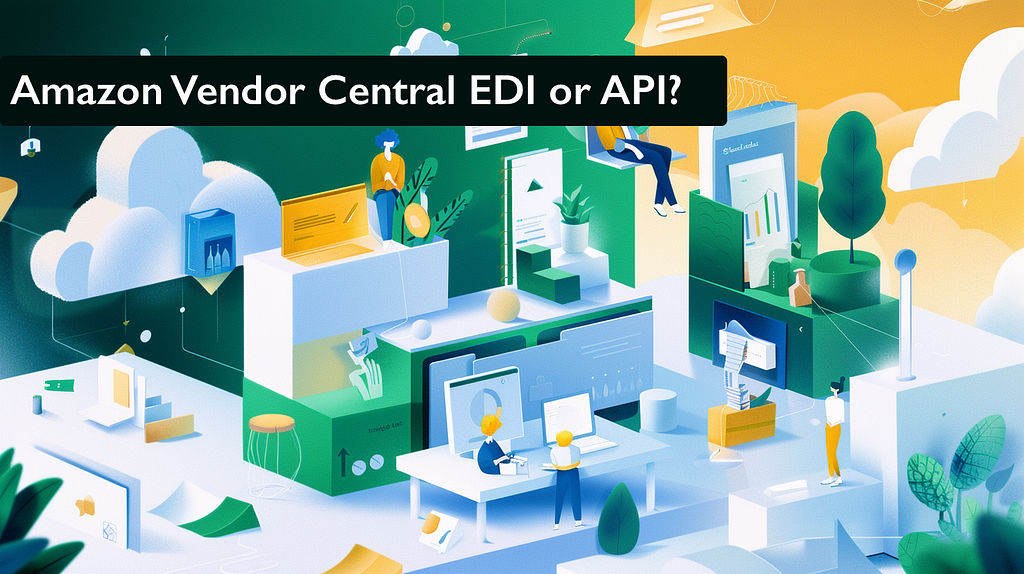
Amazon EDI or SP-API? Choosing the right Vendor integration options
Amazon Vendor Central provides invaluable data for managing and growing your business with Amazon Retail. You can monitor retail KPIs, evaluate performance, identify operational improvement opportunities, and glean insights to shape your business strategy through vendor-specific dashboards.
However, understanding the best way to integrate this data — whether through EDI or the newer SP-API — can be challenging.
Why Choose Amazon Vendor Central API Over EDI?
While Electronic Data Interchange (EDI) has been a traditional method for managing supply chain messages, the Selling Partner API (SP-API) offers a more modern, efficient, and cost-effective solution. Here’s why:
- Lower Infrastructure and Development Costs: SP-API requires less infrastructure and development costs than EDI, making it a more cost-effective vendor choice.
- Ease of Use: SP-API is easier to use than EDI and does not require specialized knowledge. Your team can quickly adapt to the new system and leverage its benefits.
- Near Real-Time Processing: With SP-API, you can enjoy efficient near-real-time data processing, making timely decisions based on the most up-to-date information.
- Data Parity: SP-API ensures data parity across reports and Amazon Retail Analytics dashboards in Vendor Central, providing a consistent and reliable view of your business performance.
- Flexible Data Aggregation: SP-API allows you to specify and request data from different time range aggregations, such as daily, weekly, monthly, quarterly, yearly, and trailing four weeks. This allows you to analyze your data at the granularity that matters most to your business.
- Easy Access to Historical Data: With SP-API, you can easily access data backfills for historical data, enabling you to analyze trends and make informed decisions based on past performance.
Amazon Cendor EDI Integration Overview
While SP-API is the preferred integration method, Amazon also offers EDI integration for vendors who wish to integrate their existing EDI system with Amazon’s. The EDI Integration feature provides a solution for integrating your company’s EDI system without the need to contact Amazon directly.
You will enter the relevant information for your EDI setup during the integration process and learn about Amazon’s EDI requirements. A series of tests will ensure that the entered information and your message mapping comply with Amazon’s requirements.
Supported Messages for EDI Integration The EDI Integration feature supports various message types and EDI standards for both Amazon Retail (warehouse orders) and Direct Fulfillment (direct to customer) business types. Some of the supported message types include:
- Purchase orders
- Purchase order acknowledgments
- Advance shipment notifications
- Invoices
- Remittance advice
- Cost and inventory feeds
- Routing requests and instructions
- Order fulfillment requests and responses
- Inventory availability advice
- Ship label requests and responses
- Shipment status
EDI Integration Process The EDI Integration feature is divided into three sections: Home, the Messages dashboard, and the Connection dashboard. The process involves:
- Access the EDI Integration feature under the Integration (EDI/API) tab and start EDI for the desired vendor code.
- Selecting whether to set up a new connection or reuse one from another EDI-enabled Amazon vendor account.
- Configuring global settings and selecting supported message types to test and schedule for production.
- Setting up a connection endpoint using AS2, hosted SFTP, or VAN/EDI Service Provider as connectivity protocols.
Use Case: Looking at Amazon Retail Analytics
Amazon Retail Analytics (ARA) is a powerful vendor-specific dashboard that provides the data you need to manage and grow your business on Amazon Retail. With ARA, you can monitor key performance indicators (KPIs), evaluate your performance, identify improvement opportunities, and gain valuable insights to shape your business strategy.
Mapping Amazon Retail Analytics EDI Transactions to API Report Types
To help you transition from EDI to SP-API, Amazon maps EDI transactions to API report types. Here’s a quick overview:
Table 1: Mapping Amazon Retail Analytics EDI Transactions to API Report Types
Name | EDI Transaction Value | API Report Type Value
-------------------------------------------------------------------------------------------------
Sales Diagnostic | Sales (X12 852, EDIFACT SLSRPT) | GET_VENDOR_SALES_REPORT
Inventory Health & Planning | Sales (X12 852, EDIFACT SLSRPT) | GET_VENDOR_INVENTORY_REPORT
Forecasting | Forecasting (X12 830, EDIFACT DELFOR) | GET_VENDOR_FORECASTING_REPORT
Table 2: Mapping Amazon Retail Analytics Data Elements from EDI to API
Dataset | EDI Report | EDI Data Element | EDI Element Description | API Report | API Element Description
-----------------------------------------------------------------------------------------------------------------------------------------------------------------------------------------
Sales | Sales report (X12 852, EDIFACT SLSRPT) | X12: AMT*8T / EDIFACT: MOA+36E | ordered_product_sales | GET_VENDOR_SALES_REPORT | orderedRevenue
Sales | Sales report (X12 852, EDIFACT SLSRPT) | X12: ZA*QS / EDIFACT: QTY+153 | customer_ordered_units | GET_VENDOR_SALES_REPORT | orderedUnits
Sales | Sales and inventory report (X12 852) | X12: ZA*TS | shipped_units | GET_VENDOR_SALES_REPORT | shippedUnits
Sales | n/a | n/a | n/a | GET_VENDOR_SALES_REPORT | shippedCogs
Sales | Sales and inventory report (X12 852) | X12: ZA*QU | customer_return_units | GET_VENDOR_SALES_REPORT | customerReturns
Sales | n/a | n/a | n/a | GET_VENDOR_SALES_REPORT | shippedRevenue
Traffic | n/a | n/a | n/a | GET_VENDOR_TRAFFIC_REPORT | glanceViews
Net pure product margin | n/a | n/a | n/a | GET_VENDOR_NET_PURE_PRODUCT_MARGIN_REPORT | netPureProductMargin
Inventory | Sales report (X12 852, EDIFACT SLSRPT) | X12: ZA*QA / EDIFACT: QTY+145 | sellable_on_hand_units | GET_VENDOR_INVENTORY_REPORT | sellableOnHandUnits
Inventory | Sales and inventory report (X12 852) | X12: ZA*QE | quantity_ending_balance | n/a | n/a
Inventory | Sales report (X12 852, EDIFACT SLSRPT) | X12: ZA*QP / EDIFACT: QTY+21 | quantity_on_order | GET_VENDOR_INVENTORY_REPORT | openPurchaseOrderQuantity
Inventory | Sales and inventory report (X12 852) | X12: ZA*DG | quantity_damaged | GET_VENDOR_INVENTORY_REPORT | unsellableOnHandUnits
Inventory | Sales and inventory report (X12 852) | X12: ZA*HL | quantity_on_hold | n/a | n/a
Inventory | Sales and inventory report (X12 852) | X12: ZA*QO | quantity_oos | GET_VENDOR_INVENTORY_REPORT | unfilledCustomerOrderedUnits
Inventory | Sales and inventory report (X12 852) | X12: ZA*QR | quantity_received | GET_VENDOR_INVENTORY_REPORT | netReceivedUnits
Inventory | Sales and inventory report (X12 852) | X12: ZA*DS | days_supply_daily | n/a | n/a
Inventory | Sales and inventory report (X12 852) | X12: ZA*WS | weeks_supply_daily | n/a | n/a
Inventory | Sales and inventory report (X12 852) | X12: ZA*ST | sell_through | GET_VENDOR_INVENTORY_REPORT | sellThroughRate
Inventory | Sales and inventory report (X12 852) | X12: ZA*FV | forecast_variance | n/a | n/a
Inventory | Sales and inventory report (X12 852) | X12: ZA*QI | quantity_in_transit | n/a | n/a
Inventory | n/a | n/a | n/a | GET_VENDOR_INVENTORY_REPORT | [various inventory metrics]
Forecasting | Forecast report (X12 830, EDIFACT DELFOR) | n/a | Mean forecast value (week 1-26) | GET_VENDOR_FORECASTING_REPORT | meanForecastUnits (week 1-26)
Forecasting | n/a | n/a | n/a | GET_VENDOR_FORECASTING_REPORT | [various forecast accuracy metrics]
How to Integrate with Amazon Retail Analytics Report APIs
There are two main pathways to take advantage of the SP-API, each suited for different enterprise needs. However, only one option allows vendors to get data flowing in minutes to a private, trusted data warehouse or lake: Openbridge!
1. DIY Integration
Why Choose This Path? Enterprises with strong internal development teams and a preference for full control over their data integration processes might opt for the DIY approach.
- Review the Selling Partner API Developer Guide: Familiarize yourself with the documentation and requirements.
- Complete Your Developer Profile: Apply for access to the Brand Analytics role on Vendor Central.
- Set Up Development Environments: Establish development, staging, and production environments.
- Select Coding Libraries and SDKs: Choose appropriate libraries and SDKs to facilitate integration.
- Make API Calls: Start integrating with the vendor retail analytics reports.
- Fetch SP-API Reports and Upload to S3 Bucket (1 week): Include any necessary JSON conversions.
- Load Data from S3 to a Database (e.g., Redshift) (1 week): Utilize pre-existing solutions for efficiency.
- Implement Monitoring and Error Handling: Set up systems to monitor performance and handle errors effectively.
- Manage Change Control: Keep up with API updates and deprecations to ensure continued compatibility.
- Backfill Historical Data (Optional): Use the documentation to understand the availability of historical data.
2. Openbridge: A Code-Free, Fully Automated Solution
Why Choose This Path? Enterprises seeking a rapid, hassle-free implementation with minimal setup time and no coding required will find Openbridge the perfect fit.
- Automation Accelerates Insights: Seamlessly integrate data with tools like Tableau, Looker, Power BI, Google Data Studio, and AWS Quicksight for forecasting, analysis, reporting, and marketing efforts.
- Unify Data in Your Cloud Warehouse: Consolidate data in a trusted, private data lake or cloud warehouse such as Snowflake, Azure Data Lake, AWS Redshift, AWS Redshift Spectrum, AWS Athena, and Google BigQuery.
Each pathway offers unique advantages depending on your enterprise’s needs, but only Openbridge provides a code-free, fully automated solution that gets your data up and running swiftly and securely.
Automate And Unify Your Vendor Central Data — Free For 30 Days
Openbridge automation extends beyond inventory to a broad collection of Amazon and non-Amazon data sources;
- Brand Analytics
- Retail Analytics
- Retail Procurement
- Direct Fulfillment
- Real-time Traffic, Sales, and Inventory
- Amazon Advertising
Start your journey towards data-driven growth and profit with Openbridge. Code-free, fully automated Selling Partner API integration simplifies your Amazon Vendor Central operations.
Ready to harness the power of your Amazon Vendor Central data?
→ Sign Up Now for Your Free 30-day Trial For Amazon Vendor Central Automation.
Amazon Vendor Central EDI or API Integration? was originally published in Openbridge on Medium, where people are continuing the conversation by highlighting and responding to this story.
from Openbridge - Medium https://ift.tt/nUI7Fkj
via Openbridge



